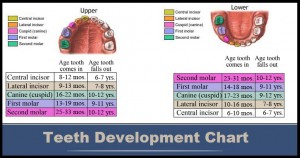When Do Babies Get Molars ?
Molars – The wider teeth towards the back side of the mouth will root out in the stage of 13 to 19 months normally. Until the pals from the bottom side appear out, there is nothing to worry about it. However, the companions of the molars from the bottom would emerge from the month of 14. Following is the chart that tells the answer to the question of when do babies get molars. A pediatrician Perter Nieman states that “when your child will let you touch his mouth, you may be able to confirm that the molars are about to break through by feeling the swollen bumps in his gum”.
Teeth development chart
Teeth: Emerging stage: Falling out stage
Upper Teeth
Central incisor: 8 to 12 months: 6 to 7 years
Lateral incisor: 9 to 13 months: 7 to 8 years
Cuspid or Canine: 16 to 22 months: 10 to 12 years
First molar: 13 to 19 months: 9 to 11 years
Second molar: 25 to 33 months: 10 to 12 years
Lower Teeth
Second molar: 23 to 31 months: 10 to 12 years
First molar: 14 to 18 months: 9 to 11 years
Cuspid to Canine: 17 to 23 months: 9 to 12 years
Lateral incisor: 10 to 16 months: 7 to 8 years
Central incisor: 6 to 10 months: 6 to 7 years
The following chart explains the stage when the baby’s’ primary teeth which are also known as deciduous teeth would root out and fall out. And there might be slight variations among the rooting out and falling out from baby to baby. As observed from the chart, the gums would get ready by the month of 6 tentatively. However around the month of 9, the baby will get its first tooth. In general, the first two teeth which root out are the central incisors (the two bottom front teeth). And the next would be the four teeth on the top front to be rooted out and gradually the other sets would begin in pairs. One on each side of both upper and lower jaw – ten each! All such sets will be completely developed by the age between 2 to 3 years old. Appending below is a detailed structure for the query of when do babies get molars.
Upper & Lower Lateral Incisors: Around the months between 12 and 15, the teeth on the either side of the central teeth would make their initial show out. The first molars are in the queue to break out the guns to show their pop-out during 13 to 19 months, wherein for some baby’s it can be delayed period also, say for around 18 or 19th month. And be alert to take care of your little one, wherein the molars might hurt a lot because of its duly big size when compared to the other teeth. So it is advised to be ready with all kind if soothing techniques to relief your little bun from the teething pain.
Around the month of 15 to 18 months, your little one will get canines – the pointing fang teeth which will come in between the lateral incisors and the first molars. Wherein, the lower canines will take few more months to root out than the upper ones. The months of 18 to 24 are the stage of second molars or the back molars to be rooted out. The bottom molars will pop out at the age of the second year while completing the age. But you know that these molars will not rear their pearly pop outs after 2 years.
The last set of molars will tentatively pop out by the month between 24 and 36. And by the month of 36, your little one will show all his/her 20 numbers of tooth beautifully. Not only knowing that when do babies get molars, below appending are few facts that are of interesting:
Facts about primary teeth
- As per the general medical rule, for period of every six months, there will be rooting out of 4 teeth approximately.
- Baby girls start teething earlier as compared to baby boys.
- Teeth on both the jaws will root in pairs as one on the right side & left side.
- Primary teeth will be smaller in size and crystal white in colour than that of the permanent teeth which follow after falling out process.
- By the age of 3, the child will get all of his/her primary teeth completely.
The importance of taking care of babies while teething
When you are very curious about that when do babies get molars or When Do Babies Start Teething there are lots of important points that have to be kept in the mind to ensure proper care and soothing of the baby. Though baby teeth or primary teeth stay for a shorter time period until the permanent one comes, baby teeth:
1. Occupy space for the permanent teeth parts
2. Give the face a perfect shape & appearance
3. Provide perfect aid for the development of speech clarity
4. Provide aid in attaining good supplementary nutrition by chewing
5. Provide a nourished foundation for the permanent teeth
A Glimpse of Babies dental health
Parents must well know about the dental health and the risks in the same to maintain a healthy dental development for the babies. Wherein, decay and infection might affect the baby from intake of any food that leads to poor health. In addition, it will ruin the perfection on both space and strength for the following permanent teeth. And especially when do babies get molars, parents must be very careful hence those are bigger teeth causing lot more pain when to compare to the other set of teething.
Some children do go through the process of teething easily with little illness. But for others, the teething might be off days with drooling, tetchiness and perhaps picky. On rare cases, children who really suffer may cry often due to pain, and have a disturbed and miserable sleep at night.
Time to visit dentist
When you feel the temperature of your baby is slightly increasing, or high along with loose stools it is must to visit the doctor. In addition, if your baby drools with tender gums, it is advised to visit the doctor. However there might be some sickness in due course of teething, wherein, below appending are the signs & symptoms for your checklist to be prepared.
- When there is no use of painkiller medicines.
- When the temperature is high, over 40º Celsius and it is not decreased by the medicines.
- The baby seems to be in severe pain and feels really tired and tetchy.
- When the baby pukes or vomits rare or often times.
- Diarrhea accompanied with blood in the mucus and very watery.
- And most importantly, when the above-discussed signs & symptoms last for more than 3 days
Hence, just go for common soothing techniques to help your baby and practice them regularly. Happy soothing your baby!





